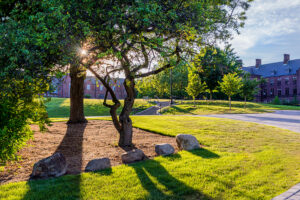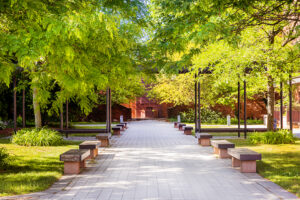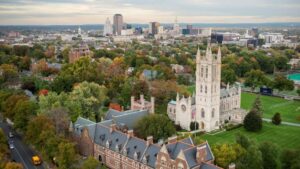The Hundred Acre Wood: Trinity College Campus is Designated an Arboretum
Nestled amid buildings and roadways in the city of Hartford, Trinity College’s tree-lined campus invites people to interact with the natural environment, an activity that was formally acknowledged with its new designation as an arboretum.
In March, the independent accrediting agency ArbNet approved the arboretum status for the campus, which is home to more than 1,500 trees and dozens of tree species spread over about 100 acres. Including Trinity, there are 11 accredited arboreta in Connecticut.

“Establishing the Trinity College Arboretum is a significant milestone in our commitment to local ecology and the culmination of years of discussion and volunteer efforts,” said Susan A. Masino, Trinity College Vernon D. Roosa Professor of Applied Science. “Our campus is an oasis of natural beauty, and it will serve as a model for future urban arboreta and their benefits to the health of the community and beyond.”
Trinity’s campus is among hundreds of sites across more than three dozen nations that have been accredited by ArbNet, the only global program to certify arboreta. The designation recognizes sites that have met a rigorous set of industry standards.
In pursuing the application, Trinity students and faculty identified and labeled 37 tree species on campus. The arboretum includes two Connecticut state champion trees—an English Elm and a Temple’s Upright Sugar Maple—the largest known trees of those species in the state. American Elms feature heavily in the arboretum and are referenced in Trinity’s alma mater “’Neath the Elms.”
 Importantly, the Trinity Arboretum protects, enhances, and sustains an urban forest that will celebrate the region’s natural heritage and history.
Importantly, the Trinity Arboretum protects, enhances, and sustains an urban forest that will celebrate the region’s natural heritage and history.
The ArbNet accreditation coincides with two milestones. First, it falls during the yearlong bicentennial celebration of Frederick Law Olmsted, who was born in Hartford in 1822, and whose style influenced Trinity’s campus design.
And 2023 marks Trinity’s own Bicentennial. As part of Trinity’s celebration, the College is reviving the tradition of planting a new tree each year on Charter Day, May 16, in recognition of its founding.
Today, the campus functions as a gathering place for conservation efforts and community engagement, and serves as a living lab for teaching, research, and respite. Admissions visitors are introduced to many tree species along the College’s regular tour route, and the walking tour is available online.
The formal designation by ArbNet shines new light on ongoing sustainability efforts. When recently developing a Sustainability Action Plan, Trinity cited stewardship of the campus as a critical part of its education and research. The green footprint of the campus is further enhanced by neighboring Zion Hill Cemetery and Rocky Ridge Park, and by nearby Olmsted-designed Pope Park.
 Today, Trinity is taking care of its current trees while formalizing plans for new plantings in specific areas of campus. The College is committed to adding native species, including the dozen oak species native to New England. Tree additions and replacements will focus on supporting biodiversity and public health and mitigating impacts of climate change.
Today, Trinity is taking care of its current trees while formalizing plans for new plantings in specific areas of campus. The College is committed to adding native species, including the dozen oak species native to New England. Tree additions and replacements will focus on supporting biodiversity and public health and mitigating impacts of climate change.
Hayley Berliner, Trinity’s sustainability coordinator, said, “The Trinity College Arboretum reflects our enduring commitment to supporting sustainability efforts and Trinity’s strategic vision while simultaneously offering new opportunities for engagement, learning, financial support, and conservation.”
Masino added, “On the eve of Trinity’s Bicentennial, we wanted to officially formalize our dedication to conserving nature for the future.”
